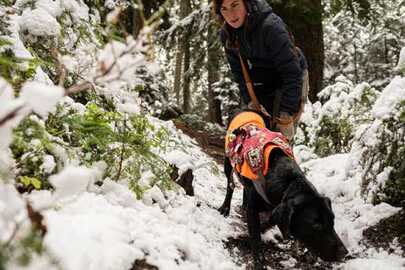Welcome back to Science Sunday Jasper searches for scat as part of the Center for Conservation Biology wolf project Jasper searches for scat as part of the Center for Conservation Biology wolf project Invasive species, poaching, monitoring rare species, the list of conservation functions in which dogs can contribute is long and growing. Dogs have long been used to detect many types of contraband in controlled environments, however performing these tasks in the field present a whole new array of challenges. For example dogs used to detect zebra muscles on recreational watercraft may require a whole different set of characteristics than his counterpart employed in preventing poaching through detection of guns and ammunition before animals are poached. Conservation detection now encompasses an array of activities, including detection of live wildlife, carcass detection for birds and bats around wind turbines, and detection of scats, pathogens, and other biological materials. Several reports indicate that, in many cases, Conservation Detection Dogs (CDDs) are more efficient than several other survey methods in detecting the presence/absence, and relative abundance, of plants and wildlife. Notwithstanding the prevalence and importance of CDDs, there is little information with respect to the selection training and handling of dogs across various functions. CDD performance may be impacted by many factors. For example, environmental terrain/vegetation density, specific search target, and whether the target is terrestrial, arboreal, or marine. Having said that, there have been studies by individual organisations in the selection and training of CDDs. Obviously olfactory competence will be a consideration in any discipline. While one might presume that a number of odour receptor cells above some theoretical threshold level is required, many other traits also determine success. In this respect, it is instructive to consider the type of scent being detected. In scent detection work there are three search types that a dog can perform: air-scenting, in which the nose of the dog is held in the air “sniffing” to catch scent on the wind; tracking, where the nose is held close to the ground, following the scent and direction of the target; and, trailing, in which dogs use a combination of air-scenting and tracking techniques. While Bloodhounds possess the largest number of odour receptor cells, other factors make them less suitable for conservation detection tasks. For example, pugs appear capable of performing scent detection tasks to a similar standard to German Shepherd Dogs, however are unable to maintain body temperature in extreme environments. Similarly giant breeds such as Great Danes large size may make it difficult for them to cool down when working in strenuous environmental conditions or hot weather. Available studies show a strong trend toward using working and sporting dog breeds for conservation work. Most dogs possess the olfactory competence to perform the work, however the more important factor is the individuals temperament. Studies have identified seven psychological factors to be considered:
The handler is as important in the enterprise as the selection of the dog. The handler requires the same endurance and dedication as the dog and the rapport between them must promote the success of the endeavour. Although there has been little cross functional literature on CDD selection, the search and rescue community has developed an evaluation protocol known as the Brownell–Marsolais scale. This scale reportedly allows one to measure pack, food, and play drives, as well as motivation and nerve strength, in scent detection dog candidates. The text of this treatise can be found at here . Skip to page 4 for the meat of the report.
0 Comments
Leave a Reply. |
|
PHONE US AT 705-652-0682
|
Other enterprises under the DueNorth Brand: DueNorth Pet Care for excellent dog Boarding, Duenorth Flatcoated Retrievers for beautiful flatcoats
 RSS Feed
RSS Feed